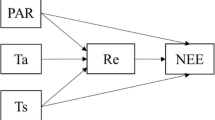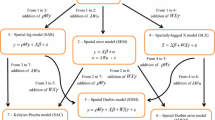Abstract
Sequential Gaussian Simulation is a commonly used geostatistical method for populating a grid with a Gaussian random field. The theoretical foundation of this method implies that all previously simulated nodes, referred to as neighbors, should be included in the kriging system of each newly simulated node. This would, however, require solving a large number of linear systems of increasing size as the simulation progresses, which, for computational reasons, is generally not feasible. Traditionally, this problem is addressed by limiting the number of neighbors to the ones closest to the simulated node. This does, however, result in artifacts in the realization. The simulation path, that is, the order in which nodes are visited, is known to influence the location and magnitude of these artifacts. So far, few rigorous studies linking the simulation path to the associated biases are available and, correspondingly, recommendations regarding the choice of the simulation path are largely based on empirical evidence. In this study, a comprehensive analysis of the influence of the path on the simulation errors is presented, based on which guidelines for choosing an optimal path were developed. The most common path types are systematically assessed based on the comparison of the simulation covariance matrices with the covariance of the underlying spatial model. Our analysis indicates that the optimal path is defined as the one minimizing the information lost by the omission of neighbors. Classification into clustering paths, that is, paths simulating consecutively close nodes, and declustering paths, that is, paths simulating consecutively distant nodes, was found to be an efficient way of determining path performance. Common examples of the latter are multi-grid, mid-point, and quasi-random paths, while the former include row-by-row and spiral paths. Indeed, clustering paths tend to inadequately approximate covariances at intermediate and large lag distances, because their neighborhood is only composed of nearby nodes. On the other hand, declustering paths minimize the correlation among nodes, thus ensuring that the neighbors are more diverse, and that only weakly correlated neighbors are omitted.










Similar content being viewed by others
Change history
06 September 2017
An erratum to this article has been published.
References
Abdu H, Robinson DA, Seyfried M, Jones SB (2008) Geophysical imaging of watershed subsurface patterns and prediction of soil texture and water holding capacity. Water Resour Res 44(4):W00D18. doi:10.1029/2008WR007043
Barnsley MF, Devaney RL, Mandelbrot BB, Peitgen HO, Saupe D, Voss RF (1988) The science of fractal images. Springer, New York. doi:10.1007/978-1-4612-3784-6
Boulanger F (1990) Modélisation et simulation de variables régionalisées par des fonctions aléatoires stables. Ph.D. thesis, Ecole des Mines de Paris, Fontainebleau
Box GEP, Jenkins GM, Reinsel GC (2008) Time series analysis, vol 37. Wiley, Hoboken. doi:10.1002/9781118619193
Chilès JP, Delfiner P (1999) Geostatistics, Wiley series in probability and statistics, vol 497. Wiley, Hoboken. doi:10.1002/9780470316993
Daly C (2005) Higher order models using entropy, Markov random fields and sequential simulation. In: Leuangthong O, Deutsch CV (eds) Geostatistics Banff 2004. Quantitative Geology and Geostatistics, vol 14. Springer, Dordrecht
Day-Lewis FD, Lane JW (2004) Assessing the resolution-dependent utility of tomograms for geostatistics. Geophys Res Lett 31(7):L07,503. doi:10.1029/2004GL019617
Delbari M, Afrasiab P, Loiskandl W (2009) Using sequential Gaussian simulation to assess the field-scale spatial uncertainty of soil water content. Catena 79(2):163–169. doi:10.1016/j.catena.2009.08.001
Deutsch CV, Journel AG (1992) GSLIB: Geostatistical software library and user’s guide. Technical Representative, New York
Dimitrakopoulos R, Luo X (2004) Generalized sequential Gaussian simulation on group size and screen-effect approximations for large field simulations. Math Geol 36(5):567–591. doi:10.1023/B:MATG.0000037737.11615.df
Dimitrakopoulos R, Farrelly CT, Godoy M (2002) Moving forward from traditional optimization: grade uncertainty and risk effects in open-pit design. Min Technol 111(1):82–88. doi:10.1179/mnt.2002.111.1.82
Emery X (2004) Testing the correctness of the sequential algorithm for simulating Gaussian random fields. Stoch Env Res Risk Assess 18(6):401–413. doi:10.1007/s00477-004-0211-7
Emery X, Peláez M (2011) Assessing the accuracy of sequential Gaussian simulation and cosimulation. Comput Geosci 15(4):673–689. doi:10.1007/s10596-011-9235-5
Fournier A, Fussell D, Carpenter L (1982) Computer rendering of stochastic models. Commun ACM 25(6):371–384. doi:10.1145/358523.358553
Gómez-Hernández JJ, Cassiraga EF (1994) Theory and practice of sequential simulation. Kluwer Academic Publishers, Dordrecht. doi:10.1007/978-94-015-8267-4_10
Gómez-Hernández JJ, Journel AG (1993) Geostatistics Tróia ’92, quantitative geology and geostatistics, vol 5. Springer, Dordrecht. doi:10.1007/978-94-011-1739-5
Goovaerts P (1997) Geostatistics for natural resources evaluation. Oxford University Press, Oxford
Goovaerts P (2001) Geostatistical modelling of uncertainty in soil science. Geoderma 103(1–2):3–26. doi:10.1016/S0016-7061(01)00067-2
Halton JH (1960) On the efficiency of certain quasi-random sequences of points in evaluating multi-dimensional integrals. Numer Math 2(1):84–90. doi:10.1007/BF01386213
Hansen TM, Journel AG, Tarantola A, Mosegaard K (2006) Linear inverse Gaussian theory and geostatistics. Geophysics 71(6):R101–R111. doi:10.1190/1.2345195
Isaaks EH (1991) The application of Monte Carlo methods to the analysis of spatially correlated data. Ph.D. thesis, Stanford University
Isaaks EH, Srivastava RM (1989) An introduction to applied geostatistics. Oxford University Press, New York
Johnson ME (1987) Multivariate statistical simulation. Wiley series in probability and statistics. Wiley, Hoboken. doi:10.1002/9781118150740
Journel AG (1989) Fundamentals of geostatistics in five lessons, vol 16. American Geophysical Union, Washington. doi:10.1029/SC008
Juang KW, Chen YS, Lee DY (2004) Using sequential indicator simulation to assess the uncertainty of delineating heavy-metal contaminated soils. Environ Pollut 127(2):229–238. doi:10.1016/j.envpol.2003.07.001
Kocis L, Whiten WJ (1997) Computational investigations of low-discrepancy sequences. ACM Trans Math Softw 23(2):266–294. doi:10.1145/264029.264064
Lantuéjoul C (2002) Geostatistical simulation. Springer, Berlin. doi:10.1007/978-3-662-04808-5
Lee SY, Carle SF, Fogg GE (2007) Geologic heterogeneity and a comparison of two geostatistical models: sequential Gaussian and transition probability-based geostatistical simulation. Adv Water Resour 30(9):1914–1932. doi:10.1016/j.advwatres.2007.03.005
Leuangthong O, McLennan JA, Deutsch CV (2004) Minimum acceptance criteria for geostatistical realizations. Nat Resour Res 13(3):131–141. doi:10.1023/B:NARR.0000046916.91703.bb
Lin YP, Chang TK, Teng TP (2001) Characterization of soil lead by comparing sequential Gaussian simulation, simulated annealing simulation and kriging methods. Environ Geol 41(1–2):189–199. doi:10.1007/s002540100382
McLennan J (2002) The effect of the simulation path in sequential gaussian simulation. Technical Representative, University of Alberta
Meyer TH (2004) The discontinuous nature of kriging interpolation for digital terrain modeling. Cartogr Geogr Inf Sci 31(4):209–216. doi:10.1559/1523040042742385
Mowrer H (1997) Propagating uncertainty through spatial estimation processes for old-growth subalpine forests using sequential Gaussian simulation in GIS. Ecol Model 98(1):73–86. doi:10.1016/S0304-3800(96)01938-2
Omre H, Sølna K, Tjelmeland H (1993) Simulation of random functions on large lattices. In: Soares A (ed) Geostatistics Tròia ’92. Kluwer Academic Publishers, Dordrecht, pp 179–199. doi:10.1007/978-94-011-1739-5_16
Rivoirard J (1984) Le comportement des poids de krigeage. Ph.D. thesis, Ecole des Mines de Paris, Fontainebleau
Safikhani M, Asghari O, Emery X (2017) Assessing the accuracy of sequential gaussian simulation through statistical testing. Stoch Env Res Risk Assess 31(2):523–533. doi:10.1007/s00477-016-1255-1
Srinivasan BV, Duraiswami R, Murtugudde R (2008) Efficient kriging for real-time spatio-temporal interpolation Linear kriging. In: 20th conference on probablility and statistics in atmospheric sciences, pp 228–235
Tran TT (1994) Improving variogram reproduction on dense simulation grids. Comput Geosci 20(7–8):1161–1168. doi:10.1016/0098-3004(94)90069-8
Trefethen LN, Bau D III (1997) Numerical linear algebra, vol 50. SIAM, Philadelphia
Verly GW (1993) Sequential Gaussian cosimulation: a simulation method integrating several types of information. In: Soares A (ed) Geostatistics Tròia ’92. Kluwer Academic Publishers, Dordrecht, pp 543–554. doi:10.1007/978-94-011-1739-5_42
Zhao Y, Xu X, Huang B, Sun W, Shao X, Shi X, Ruan X (2007) Using robust kriging and sequential Gaussian simulation to delineate the copper- and lead-contaminated areas of a rapidly industrialized city in Yangtze River Delta, China. Environ Geol 52(7):1423–1433. doi:10.1007/s00254-007-0667-0
Acknowledgements
This study has been supported by a Grant from the Swiss National Research Foundation.
Author information
Authors and Affiliations
Corresponding author
Additional information
The original version of this article was revised: The spelling of the third author was incorrect. The correct name is Erwan Gloaguen.
An erratum to this article is available at https://doi.org/10.1007/s11004-017-9703-0.
Rights and permissions
About this article
Cite this article
Nussbaumer, R., Mariethoz, G., Gloaguen, E. et al. Which Path to Choose in Sequential Gaussian Simulation. Math Geosci 50, 97–120 (2018). https://doi.org/10.1007/s11004-017-9699-5
Received:
Accepted:
Published:
Issue Date:
DOI: https://doi.org/10.1007/s11004-017-9699-5




